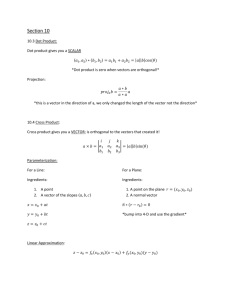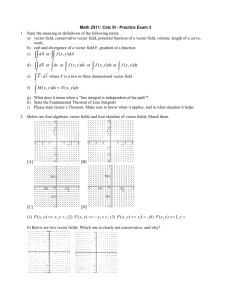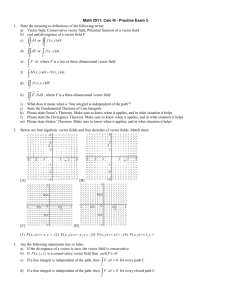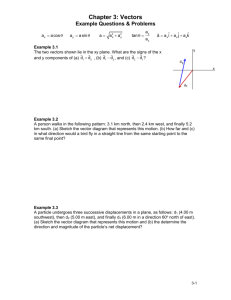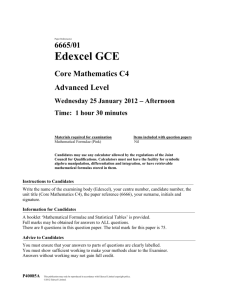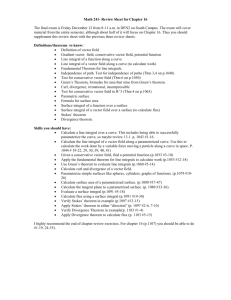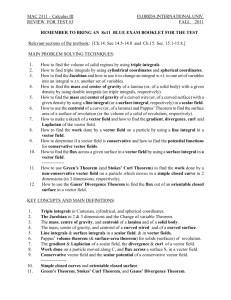Exam 3 Practice
advertisement
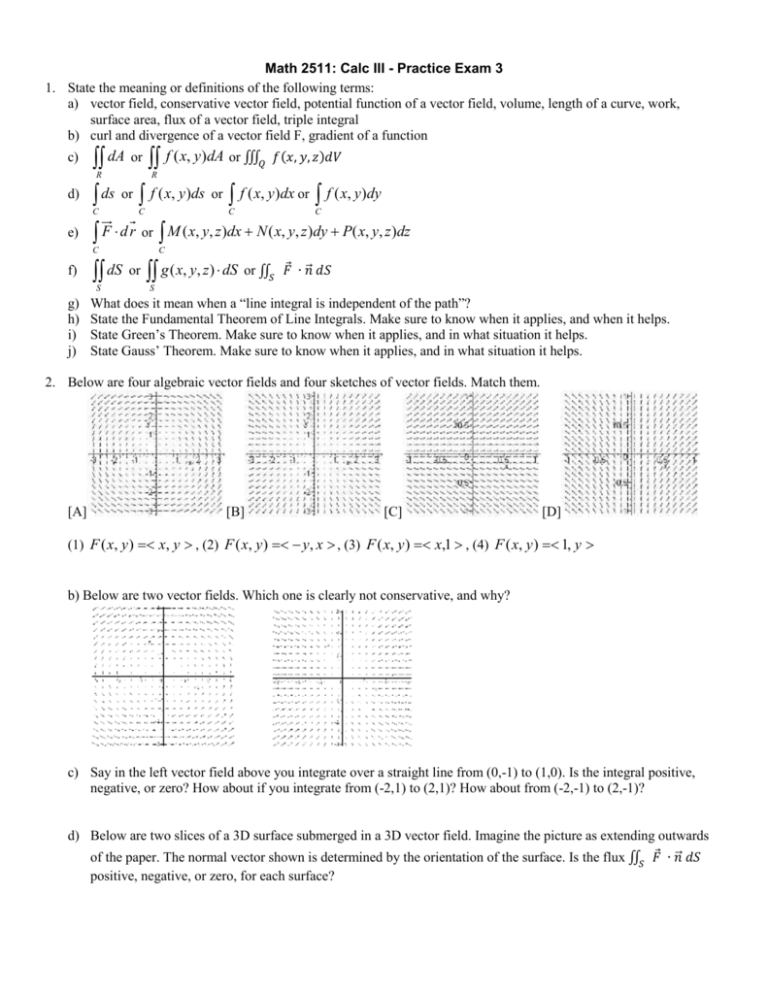
Math 2511: Calc III - Practice Exam 3 1. State the meaning or definitions of the following terms: a) vector field, conservative vector field, potential function of a vector field, volume, length of a curve, work, surface area, flux of a vector field, triple integral b) curl and divergence of a vector field F, gradient of a function c) dA or f ( x, y)dA or ∭𝑄 R d) ds or f ( x, y)ds or f ( x, y)dx or f ( x, y)dy C e) 𝑓(𝑥, 𝑦, 𝑧)𝑑𝑉 R C C C F d r or M ( x, y, z)dx N ( x, y, z)dy P( x, y, z)dz C C f) dS or g ( x, y, z) dS or ∬𝑆 g) h) i) j) What does it mean when a “line integral is independent of the path”? State the Fundamental Theorem of Line Integrals. Make sure to know when it applies, and when it helps. State Green’s Theorem. Make sure to know when it applies, and in what situation it helps. State Gauss’ Theorem. Make sure to know when it applies, and in what situation it helps. S 𝐹⃗ ∙ 𝑛⃗⃗ 𝑑𝑆 S 2. Below are four algebraic vector fields and four sketches of vector fields. Match them. [A] [B] [C] [D] (1) F ( x, y ) x, y , (2) F ( x, y ) y, x , (3) F ( x, y ) x,1 , (4) F ( x, y ) 1, y b) Below are two vector fields. Which one is clearly not conservative, and why? c) Say in the left vector field above you integrate over a straight line from (0,-1) to (1,0). Is the integral positive, negative, or zero? How about if you integrate from (-2,1) to (2,1)? How about from (-2,-1) to (2,-1)? d) Below are two slices of a 3D surface submerged in a 3D vector field. Imagine the picture as extending outwards of the paper. The normal vector shown is determined by the orientation of the surface. Is the flux ∬ 𝐹⃗ ∙ 𝑛⃗⃗ 𝑑𝑆 𝑆 positive, negative, or zero, for each surface? 3. Are the following statements true or false: a) If the divergence of a vector is zero, the vector field is conservative. b) If F ( x, y, z ) is a conservative vector field then curl ( F ) 0 c) If a line integral is independent of the path, then ∬𝑆 𝐹 ∙ 𝑛 𝑑𝑆 = 0 for every path surface S d) If a vector field is conservative then F dr 0 for every closed path C C e) dA gives the surface area of the region R R f) f ( x, y)dA gives the volume of the region under the surface f(x,y) and over R, if f is positive. R g) ∭𝑄 𝑑𝑉 gives the volume of Q h) Can you apply the Fundamental Theorem of line integrals for the function f ( x, y, z ) xy sin( z ) cos( x 2 y 2 ) ? i) Can you apply the Fundamental Theorem of line integrals for the vector field F ( x, y) 6 xy2 3x 2 ,6 x 2 y 3 y 2 7 ? j) Can you apply Green’s theorem for a curve C, which is a straight line from (0,0,0) to (1,2,3)? k) Can you apply Green’s theorem for a vector field 𝐹 =< 𝑥𝑦, 𝑦𝑧, 𝑧𝑥 > and a closed surface S? l) Can you apply Gauss’ theorem for a vector field 𝐹 =< 𝑥𝑦, 𝑦𝑧, 𝑧𝑥 > and a surface S given by 𝑧 = 𝑓(𝑥, 𝑦) 4. Suppose that F ( x, y, z ) x 3 y 2 z, x 2 z, x 2 y is some vector field. Find, if possible a) div(F), curl(F), div(div(F)), curl(curl(F)), div(curl(F)), curl(div(F)), grad(curl(F)),and grad(div(F)) b) grad., div., and curl of the vector field if appropriate for x 2 , y 2 , z 2 c) grad., div., and curl of the vector field if appropriate for cos( y ) y cos( x), sin( x) x sin( y ), xyz d) grad., div., and curl of the vector field if appropriate for f ( x, y, z ) z ln( x 2 y 2 ) 5. Decide which of the following vector fields are conservative. If a vector is conservative, find its potential function a) F ( x, y) 2 xy, x 2 b) c) F ( x, y) e x cos( y), e x sin( y) F ( x, y, z ) sin( y ), x cos y,1 d) F ( x, y, z ) 2 xy, x 2 z 2 ,2 zy e) F ( x, y) 6 xy2 3x 2 ,6 x 2 y 3 y 2 7 f) F ( x, y) 2 y 3 sin( 2 x),3 y 2 (1 cos( 2 x) g) F ( x, y, z ) 4 xy z,2 x 2 6 y,2 z h) F ( x, y, z ) 4 xy z 2 ,2 x 2 6 yz,2 xz 6. Evaluate the following integrals: a) cos( x R 2 )dA where R is the triangular region bounded by y = 0, y = x, and x = 1 1 2y b) x 2 y 3dxdy 0 1 c) ds , where C is the curve given by r (t ) t 2 ,1 t , 0 t 2 (you might want to use Maple at some point) C d) x 2 y 3dx , where C is the curve given by r (t ) t 2 , t 3 , 0 t 2 2 y 3ds where C is the circle r (t ) 2 cos(t ),2 sin( t ) , 0 t 2 y 3 zds where C is a line segment given by r (t ) t ,2t ,3t , 0 t 1 C e) x C f) x C g) F dr where F ( x, y) y, x 2 and C is the curve given by r (t ) 4 t ,4t t 2 , 0 t 3 C h) F ( x, y) yz, x 2 , zy and C is the curve given by r (t ) 1 t ,3t ,2 t 2 , 1 t 3 F dr where C i) ydx x dy where C is a parabolic arc given by r(t) t,1 t 2 2 , 1 t 1 C j) Find the surface integral x 2 y zdS , where S is the surface z 10 2 x 2 y such that x is between 0 and S 2 and y is between 0 and 4. k) ( x z)dS where S is the first-octant portion of the cylinder y 2 z 2 9 between x = 0 and x = 4 S 7. For some of the following line integrals there may be short-cut you can use to simplify your computations (but justify your shortcut by quoting the appropriate theorem) a) F dr where F ( x, y) e x cos( y),e x sin( y) and C is the curve r (t ) 2 cos(t ),2 sin( t ) , 0 t 2 C b) 2 xyzdx x 2 zdy x 2 ydz where C is some smooth curve from (0,0,0) to (1,4,3) C c) F dr where F ( x, y) y 3 1,3xy2 1 and C is the upper half of the unit circle, from (1,0) to (-1,0) C d) F dr where F ( x, y) y x,3xy 3 2 and C is the line segment from (-1,0) to (2,3). C e) y dx ( x 3 3 3xy2 )dy where C is the path from (0,0) to (1,1) along the graph of y x 3 and from (1,1) to (0,0) C along the graph of y x . 8. Green’s Theorem a) Use Green’s theorem to find F dr where F ( x, y) y , x 3 3 3xy2 and C is the circle with radius 3, C oriented counter-clockwise (You may need the double-angle formula for cos somewhere during your computations, or use Mathematica) y x x2 y2 1 by using a vector field F ( x, y ) , and the b) Evaluate dA where R is the ellipse 2 2 4 9 R boundary C of the ellipse R. Note that we did this in class, it is a very special application of Green’s theorem. c) Find the surface integral x 2 y zdS , where S is the surface z 10 2 x 2 y such that x is between 0 and S 2 and y is between 0 and 4. d) Evaluate the flux integral 2 2 2 F n dS where F ( x, y, z) x, y, z and S is x y z 4 S e) Evaluate 2 2 2 F dr where F ( x, y, z) z , x , y and C is the boundary of the surface S given by C 2 z 4 x y 2 and z 0 , oriented counter-clockwise. f) Evaluate ∫𝐶 𝐹⃗ 𝑑𝑟⃗ where 𝐹(𝑥, 𝑦, 𝑧) =< −𝑦 2 , 𝑥, 𝑧 2 > and C is the curve bounding the ellipse S consisting of the intersection of the plane 𝑦 + 𝑧 = 2 and the cylinder 𝑥 2 + 𝑦 2 = 1 9. Evaluate the following integrals. You can use any theorem that’s appropriate: g) 2 xyzdx x zdy x 2 2 ydz where C is a smooth curve from (0,0,0) to (1,4,3) C h) ydx 2 xdy where C is the boundary of the square with vertices (0,0), (0,2), (2,0), and (2,2) C i) xy dx x 2 2 ydy , where C is given by r (t ) 4 cos(t ),2 sin( t ) , t between 0 and 2 Pi. C j) xydx x dy where C is the boundary of the region between the graphs of 2 y x 2 and y x . C 10. Prove that if F ( x, y, z ) M ( x, y, z ), N ( x, y, z ), P( x, y, z ) is any vector field where M , N , P are twice continuously differentiable then div (curl ( F )) 0 Use Green’s Theorem to prove that integrals of a conservative vector fields over closed curves are zero (assuming that the closed curve encloses a simply connected region and all conditions of Green’s theorem are satisfied).
